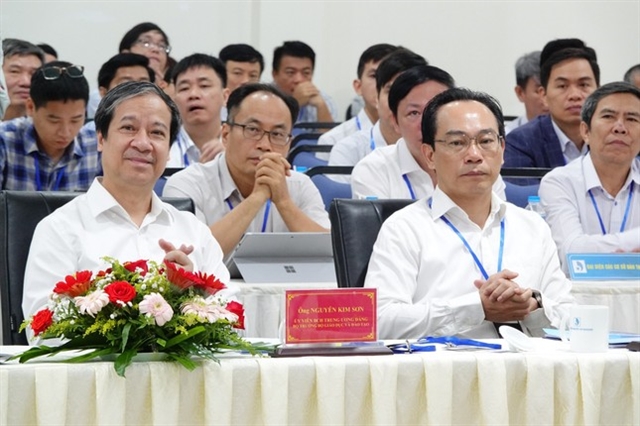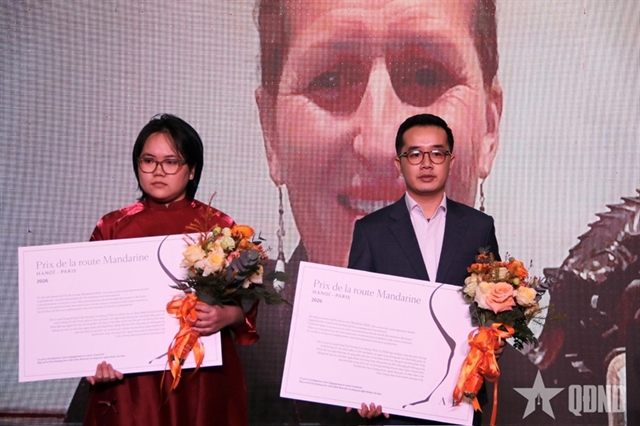 Society
Society


|
| Minister of Education and Training Nguyễn Kim Sơn (left) at the workshop. — VNA/VNS Photo |
HÀ NỘI — Forecasts from economic experts indicate that the semiconductor chip industry is poised to demand roughly 20,000 highly qualified professionals with university-level qualifications or higher in the next 5 years, and an estimated 50,000 professionals in the following 10 years.
Đà Nẵng University on Thursday hosted a workshop organised by the Ministry of Education and Training, with the primary objective of nurturing the growth of top-tier human resources tailored for the semiconductor chip industry in Vietnamese higher education institutions.
This event drew the participation of distinguished individuals and delegates from numerous central ministries and departments, along with representatives from nearly 40 leading higher education institutions in Việt Nam, specifically emphasising fields pertinent to semiconductor chip design. Moreover, the workshop also featured the presence of representatives from domestic and international businesses actively involved in semiconductor chip design.
The Ministry of Education and Training highlighted that, in a rapidly advancing era of science and technology, particularly in electronics, semiconductors, microchips, and their role in serving electronic machinery and facilitating digital transformation, there is a global trend of relocating production and research facilities. Major technology corporations around the world, including the technological powerhouse, the United States, are actively seeking suitable locations for establishing their operations.
In recent years, Việt Nam has actively promoted a policy to incentivise higher education institutions to expand and enhance their STEM programmes, with a primary focus on disciplines related to the information and communication technology industry and other sectors essential for meeting the workforce demands of the Fourth Industrial Revolution, including AI and Big Data.
From 2019 to 2022, the number of new enrolments in STEM-related university programmes has experienced a consistent annual growth of 10 per cent, surpassing the overall growth rate of 6.5 per cent. Notably, three fields have shown the most robust average annual growth rates: computer science and IT, with an impressive 17.1 per cent, and engineering technology, with a steady 10.6 per cent growth rate.
Việt Nam's premier engineering and technology universities have demonstrated significant preparedness in terms of training capacity to fulfil the human resource needs in the semiconductor and microchip sector. This encompasses human resources for research, development, and production of semiconductor materials, with an emphasis on training in fields such as chemistry, physics, and materials science.
Additionally, there is a focus on cultivating human resources for IC design and production, particularly through programmes like electronic engineering and electronics-telecommunications. Furthermore, complementary industries such as electrical engineering, control and automation, and mechatronics are also positioned to contribute to this evolving landscape.
Training options include recruiting individuals entirely new to the field, allowing students pursuing related majors to transition to specialised studies during their last one or two years of education, or enabling engineers with backgrounds in adjacent disciplines to complete additional training courses lasting several months to two years, tailored to meet the specific requirements of the semiconductor and microchip sectors.
Currently, the IC design workforce comprises approximately 5,000 professionals. According to experts, the anticipated training demand for the coming years will be approximately 3,000 individuals per year, with at least 30 per cent of them being postgraduate graduates, including engineers at level 7, masters, and doctorate levels.
However, due to the nascent nature of the labour market within the semiconductor and microchip sectors, the predominant structure remains potential-oriented. The primary challenge lies in attracting students to pursue majors in these fields and enhancing their skills to meet the exacting standards demanded by American businesses. This necessitates comprehensive support policies and guidance from the government.
At present, the Ministry of Education and Training is spearheading the development of two pivotal projects slated for submission to the Prime Minister by year-end. The first project focuses on training and cultivating high-quality human resources to bolster the high technology sector, proposing comprehensive support and incentive policies for human resource development in STEM fields and high technology in general, including electronics, semiconductors, and microchips.
The second project is focused on establishing a series of advanced research and training centres specialising in 4.0 technology. This project will put forth mechanisms, policies, and investment initiatives aimed at creating research groups dedicated to high technology, closely linked with postgraduate education in high-tech fields.
Notably, the Ministry of Education and Training recently inked a Memorandum of Cooperation with Intel regarding human resource development for high-tech industries, specifically within the semiconductor chip sector. Presently, the Ministry is in the process of crafting an action plan to foster the advancement of training and research within the realms of semiconductor and microchip technology. This plan will be submitted to the Prime Minister in October, and it will provide guidance and support to institutions, encouraging them to form partnerships, share resources, and pool their capabilities for training and research initiatives.
In light of these developments, five higher education institutions, including Hà Nội National University, Hồ Chí Minh City National University, Đà Nẵng University, Hà Nội University of Science and Technology and the Institute of Posts and Telecommunications Technology, will collectively sign a Memorandum of Alliance Cooperation. Their objective is to leverage their respective potentials and strengths, consolidate action plans in conjunction with Vietnamese higher education institutions, and collectively ensure and enhance the quality and effectiveness of education and training. — VNS




